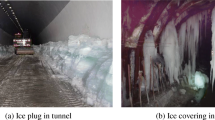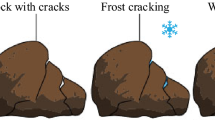Abstract
Water-bearing joints within rock engineering in cold areas are often subjected to frost heaving force in cold season due to water–ice phase transition. To evaluate the damage and stability of rock mass in cold regions, a 3D model that considers moisture migration loss during freezing and thawing was established to study the characteristics of frost heaving force within joints. Then, the numerical simulation of cyclic freeze-thawing of water-bearing joints was carried out through equivalent expansion coefficient and particle flow calculation methods. The distribution of frost heaving force in and around the joints was obtained. According to the results of the numerical tests and theoretical calculations, the frost heaving force in joints is basically stable, the tensile stress concentration area appears at the joint tip, and the frost heaving force decreases gradually away from the jointed rock mass area. The frost heaving force decreases considerably with increasing cycle number and moisture migration loss but it increases with increasing mechanical strength and joint geometric size of rock and ice. The comparison between the numerical solution of the equivalent expansion coefficient method and the theoretical solution shows that the force size and distribution law of frost heaving for the two methods are consistent.


















Similar content being viewed by others
References
AlirezaAgharazi DC, Tannant D (2012) A three-dimensional equivalent continuum constitutive model for jointed rock masses containing up to three random joint sets. Geomechan Geoeng 7:227–238
Altindag R, Alyildiz IS, Onargan T (2004) Mechanical property degradation of ignimbrite subjected to recurrent freeze–thaw cycles. Int J Rock Mech Min Sci 41:1023–1028
Antes H (1985) A boundary element procedure for transient wave propagations in two-dimensional isotropic elastic media. Finite Elem Anal Des 1:313–322
Arosio D, Longoni L, Mazza F (2013) Freeze-thaw cycle and rockfall monitoring. Landslide science and practice:385–390
Binal A (2009) A new laboratory rock test based on freeze-thaw using a steel chamber. Q J Eng GeolHydrogeol 42:179–198
Bost M, Pouya A (2017) Stress generated by the freeze–thaw process in open cracks of rock walls: empirical model for tight limestone. Bull Eng Geol Env 76:1491–1505. https://doi.org/10.1007/s10064-016-0955-6
Bouchat A, Tremblay B (2017) Using sea-ice deformation fields to constrain the mechanical strength parameters of geophysical sea ice. J Geophys Res 122:5802–5825
Cao R-h, Cao P, Lin H (2018) Failure characteristics of intermittent fissures under a compressive-shear test: Experimental and numerical analyses. Theoret Appl Fract Mech 96:740–757. https://doi.org/10.1016/j.tafmec.2017.11.002
Chen H, Fan X, Lai H, Xie Y, He Z (2019) Experimental and numerical study of granite blocks containing two side flaws and a tunnel-shaped opening. Theoret Appl Fract Mech 104:102394. https://doi.org/10.1016/j.tafmec.2019.102394
Chen Y, Yang YG, Gao F, Zhang XX (2018) Researches on damage evolution and acoustic emission characteristics of rocks. Advan Civil Eng. https://doi.org/10.1155/2018/3108065
Davidson GP, Nye JF (1985) A photoelastic study of ice pressure in rock cracks. Cold Reg Sci Technol 11:141–153
Fan X, Li K, Lai H, Xie Y, Cao R, Zheng J (2018a) Internal stress distribution and cracking around flaws and openings of rock block under uniaxial compression: A particle mechanics approach. Computers & Geotechnics
Fan X, Li K, Lai H, Zhao Q, Sun Z (2018) Experimental and numerical study of the failure behavior of intermittent rock joints subjected to direct shear load. Advan Civil Eng 2018:19. https://doi.org/10.1155/2018/4294501
Hetnarski RB, Ignaczak J (2006) Mathematical theory of elasticity. MCGRAW-HILL
Hori M, Morihiro H (1998) Micromechanical analysis on deterioration due to freezing and thawing in porous brittle materials. Int J Eng Sci 36:511–522
Huang S, Liu Q, Cheng A, Liu Y (2018) A statistical damage constitutive model under freeze-thaw and loading for rock and its engineering application. Cold Reg Sci Technol 145:142–150. https://doi.org/10.1016/j.coldregions.2017.10.015
Huang S, Liu Q, Cheng A, Liu Y, Liu G (2018) A fully coupled thermo-hydro-mechanical model including the determination of coupling parameters for freezing rock. Int J Rock Mech Min Sci 103:205–214
Huang SB, Liu QS, Cheng AP, Liu YZ (2018) A coupled hydro-thermal model of fractured rock mass under low temperature and its numerical analysis. Rock Soil Mechan 39:735–744
Jiang C, Zhang Z, He J (2020) Nonlinear analysis of combined loaded rigid piles in cohesionless soil slope. Comput Geotech 117: https://doi.org/10.1016/j.compgeo.2019.103225
Kang Y, Liu Q, Huang S (2013) A fully coupled thermo-hydro-mechanical model for rock mass under freezing/thawing condition. Cold Reg Sci Technol 95:19–26
Krautblatter M, Funk D, Günzel FK (2013) Why permafrost rocks become unstable: a rock–ice-mechanical model in time and space. Earth Surf Proc Land 38:876–887
Lei D, Lin H, Chen Y, Cao R, Wen Z (2019) Effect of cyclic freezing-thawing on the shear mechanical characteristics of nonpersistent joints. Advan Materials Sci Eng 2019:14. https://doi.org/10.1155/2019/9867681
Li JL, Zhou KP, Liu WJ, Deng HW (2016) NMR research on deterioration characteristics of microscopic structure of sandstones in freeze–thaw cycles. Transac Nonferrous Metals Soc China 26:2997–3003
Li K, Cheng Y, Yin ZY, Han DY, Meng JJ (2020) Size effects in a transversely isotropic rock under brazilian tests: laboratory testing. Rock Mech Rock Eng. https://doi.org/10.1007/s00603-020-02058-7
Li QL, Ling XZ, Hu JJ, Xu XT (2018) Experimental investigation on dilatancy behavior of frozen silty clay subjected to long-term cyclic loading. Cold Reg Sci Technol 153:156–163. https://doi.org/10.1016/j.coldregions.2018.05.008
Lin H, Yang H, Wang Y, Zhao Y, Cao R (2019) Determination of the stress field and crack initiation angle of an open flaw tip under uniaxial compression. Theoret Appl Fract Mech 104:102358. https://doi.org/10.1016/j.tafmec.2019.102358
Lin H, Zhang X, Cao R, Wen Z (2020) Improved nonlinear Burgers shear creep model based on the time-dependent shear strength for rock. Environm Earth Sci 79:149. https://doi.org/10.1007/s12665-020-8896-6
Lin H, Zhu Y, Yang J, Wen ZJ (2020) Anchor stress and deformation of the bolted joint under shearing. Advan Civil Eng 2020:3696489. https://doi.org/10.1155/2020/3696489
Liu J, Wang J, Wan W (2018) Numerical study of crack propagation in an indented rock specimen. Comput Geotech 96:1–11. https://doi.org/10.1016/j.compgeo.2017.10.014
Liu QS, Huang SB, Kang YS, Yang P, Cui XZ (2015) Numerical and theoretical studies on frost heaving pressure in a single fracture of frozen rock mass under low temperature. Chinese J Geotech Eng 37:1572–1580
Matsuoka N (2010) Direct observation of frost wedging in alpine bedrock. Earth Surf Proc Land 26:601–614
Matsuoka N, Sakai H (1999) Rockfall activity from an alpine cliff during thawing periods. Geomorphology 28:309–328
Mu JQ, Pei XJ, Huang RQ, Rengers N, Zou XQ (2017) Degradation characteristics of shear strength of joints in three rock types due to cyclic freezing and thawing. Cold Reg Sci Technol 138:91–97
Naderloo M, Moosavi M, Ahmadi M (2019) Using acoustic emission technique to monitor damage progress around joints in brittle materials. Theoret Appl Fract Mech 104:102368. https://doi.org/10.1016/j.tafmec.2019.102368
Neaupane KM, Yamabe T, Yoshinaka R (1999) Simulation of a fully coupled thermo–hydro–mechanical system in freezing and thawing rock. Int J Rock Mech Min Sci 36:563–580
Ng KLA, Small JC (1997) Behavior of joints and interfaces subjected to water pressure. Comput Geotech 20:71–93
Ping M, Li Y (2017) Estimating the three-dimensional joint roughness coefficient value of rock fractures. Bulletin of Engineering Geology & the Environment:857–866
Sass O (2004) Rock moisture fluctuations during freeze-thaw cycles: preliminary results from electrical resistivity measurements. Polar Geography 28:13–31
Shen Y, Yang H, Xi J, Yang Y, Yongzhi W, Wei X (2019) A novel shearing fracture morphology method to assess the influence of freeze–thaw actions on concrete–granite interface. Cold Reg Sci Technol 169:102900. https://doi.org/10.1016/j.coldregions.2019.102900
Shen YJ, Yang GS, Huang HW, Rong TL, Jia HL (2018) The impact of environmental temperature change on the interior temperature of quasi-sandstone in cold region: Experiment and numerical simulation. Eng Geol 239:241–253
Štefane P, Naib S, Hertelé S, De Waele W, Gubeljak N (2019) Crack tip constraint analysis in welded joints with pronounced strength and toughness heterogeneity. Theoret Appl Fract Mech 103:102293. https://doi.org/10.1016/j.tafmec.2019.102293
Wang M, Cao P, Chen Y (2017) Anisotropy of rock profile JRC values and its empirical formula: a case study on yellow rust granite. Geotech Geol Eng 35:1645–1655. https://doi.org/10.1007/s10706-017-0199-7
Wang Y, Lin H, Zhao Y, Li X, Guo P, Liu Y (2019) Analysis of fracturing characteristics of unconfined rock plate under edge-on impact loading. Eur J Environ Civil Eng 23:1–16. https://doi.org/10.1080/19648189.2018.1509021
Wang Y, Zhang H, Lin H, Zhao Y, Liu Y (2020) Fracture behaviour of central-flawed rock plate under uniaxial compression. Theoret Appl Fract Mech 106:102503. https://doi.org/10.1016/j.tafmec.2020.102503
Winkler EM (1968) Frost damage to stone and concrete: geological considerations. Eng Geol 2:315–323
Xie S, Lin H, Chen Y, Yong R, Xiong W, Du S (2020) A damage constitutive model for shear behavior of joints based on determination of the yield point. Int J Rock Mech Min Sci 128:104269. https://doi.org/10.1016/j.ijrmms.2020.104269
Xie S, Lin H, Wang Y, Chen Y, Xiong W, Zhao Y, Du S (2020) A statistical damage constitutive model considering whole joint shear deformation. Int J Damage Mech 29:1056789519900778. https://doi.org/10.1177/1056789519900778
Xing K, Zhou Z, Yang H, Liu B (2018) Macro–meso freeze–thaw damage mechanism of soil–rock mixtures with different rock contents. International Journal of Pavement Engineering:1–11
Yong R, Ye J, Li B, Du SG (2018) Determining the maximum sampling interval in rock joint roughness measurements using Fourier series. Int J Rock Mech Min Sci 101:78–88
Zhang C, Zou P, Wang Y, Jiang T, Lin H, Cao P (2020) An elasto-visco-plastic model based on stress functions for deformation and damage of water-saturated rocks during the freeze-thaw process. Constr Build Mater 250:118862. https://doi.org/10.1016/j.conbuildmat.2020.118862
Zhang CY, Lin H, Qiu CM, Jiang TT, Zhang JH (2020) The effect of cross-section shape on deformation, damage and failure of rock-like materials under uniaxial compression from both a macro and micro viewpoint. Int J Damage Mech 20:1–20. https://doi.org/10.1177/1056789520904119
Zhao Y, Tang J, Chen Y, Zhang L, Wang W, Wan W, Liao J (2017) Hydromechanical coupling tests for mechanical and permeability characteristics of fractured limestone in complete stress-strain process. Environm Earth Sci 76:24. https://doi.org/10.1007/s12665-016-6322-x
Zhao Y, Wang Y, Wang W, Tang L, Liu Q, Cheng G (2019) Modeling of rheological fracture behavior of rock cracks subjected to hydraulic pressure and far field stresses. Theoret Appl Fract Mech 101:59–66
Zhou KP, Li B, Li J-L, Deng HW, Feng B (2015) Microscopic damage and dynamic mechanical properties of rock under freeze–thaw environment. Trans Nonferrous Metals Soc China 25:1254–1261
Zhu HG, Jiang YD, Yi C, Xie HP (2014) A new geometrical model of fluid flow in rockfractures for valid application of the cubic law. Appl Mechan Materials 580–583:6
Acknowledgement
This paper gets its funding from project (51774322) supported by National Natural Science Foundation of China; Project (2018JJ2500) supported by Hunan Provincial Natural Science Foundation of China. Project (2018zzts209) supported by the fundamental Research Funds for the Central Universities of Central South University. The authors wish to acknowledge these supports. The anonymous reviewer are gratefully acknowledged for his valuable comments on the manuscript.
Author information
Authors and Affiliations
Corresponding authors
Additional information
Publisher's Note
Springer Nature remains neutral with regard to jurisdictional claims in published maps and institutional affiliations.
Rights and permissions
About this article
Cite this article
Lin, H., Lei, D., Yong, R. et al. Analytical and numerical analysis for frost heaving stress distribution within rock joints under freezing and thawing cycles. Environ Earth Sci 79, 305 (2020). https://doi.org/10.1007/s12665-020-09051-x
Received:
Accepted:
Published:
DOI: https://doi.org/10.1007/s12665-020-09051-x




